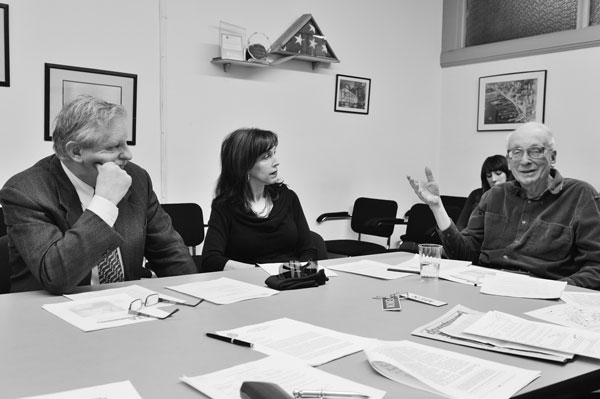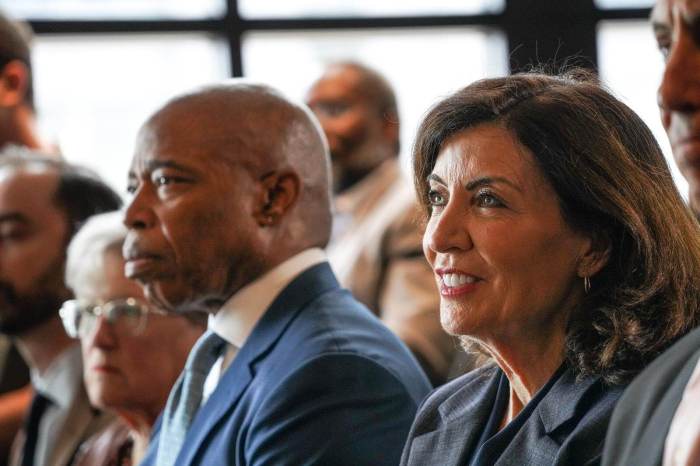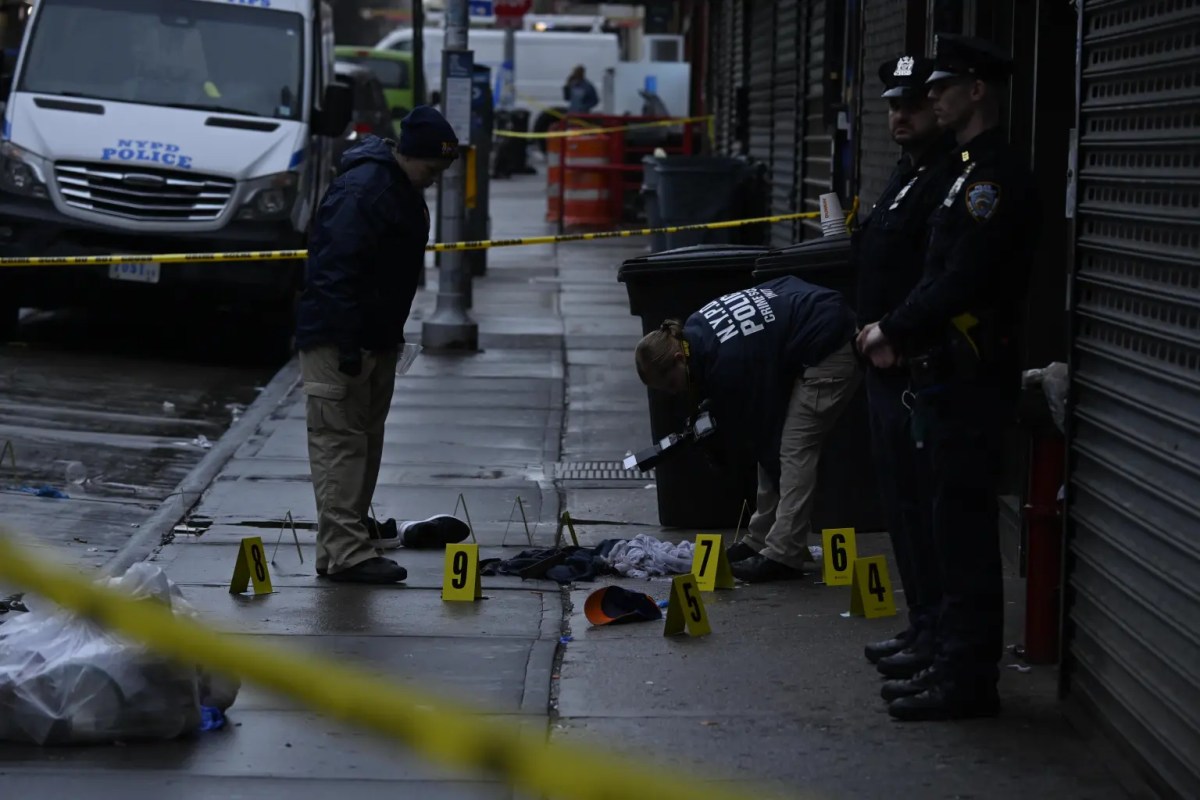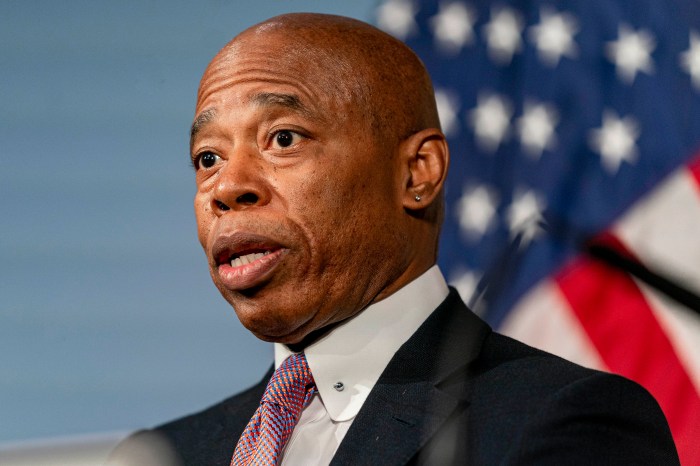 [/media-credit]
[/media-credit]
At the Jan. 5 meeting of Community Board 1’s Planning and Community Infrastructure Committee, he spoke about the city’s vulnerability, hoping the committee would join Community Boards 2 and 4 in framing a resolution asking the Army Corps of Engineers to study preventive measures against disaster.
“We’re in a lot of trouble here,” Trentlyon told the committee. “As we know, the sea level is going to be going higher and the storms are going to get more severe.” He said the city’s present mitigation policy is to create a “soft edge” of marshes on the circumference in order to lessen flooding’s effects.
“This makes a lot of sense if you’re living on Long Island,” Trentlyon said. “If you’re living in Manhattan, which is really hard edge, with giant buildings that go to the waterfront, what you really need are sea barriers.”
Trentlyon readily admits that he is not an expert on climate change, sea level rise or storm surge technology. But he consulted engineers and oceanographers who have studied these matters for years and who recommend storm surge barriers as the most effective means of defense. A storm surge barrier is essentially a wall with a gate that remains open unless needed to deflect a rush of water.
“Storm surge barriers are not a new concept,” Trentlyon told the committee. He said that in the United States, a monster hurricane in 1938 that passed over Long Island on its way to New England, killing more than 700 people and leaving a swath of destruction, was the wakeup call.
“In 1938 after the hurricane hit, three cities, New Bedford, Providence and Stamford, all built storm surge barriers,” Trentlyon said. “The problem is that by the time they built them, 30 years had passed. London has them. Rotterdam has them. Venice is building them.”
Trentlyon has long been interested in the waterfront, having been one of the early voices in Chelsea advocating for, first, creation of Chelsea Waterside Park and, then, Hudson River Park.
He said that two of the experts with whom he had talked — Douglas Hill and Malcolm J. Bowman — recommended two alternative placements for storm surge barriers to protect New York City. Hill is consulting engineer and an adjunct lecturer at the School of Marine and Atmospheric Sciences at Stony Brook University; Bowman is Distinguished Service Professor of Oceanography at the School of Marine & Atmospheric Sciences, State University of New York at Stony Brook.
One idea would be to have three barriers: at the Verrazano Narrows between Staten Island and Brooklyn; at Throgs Neck; and at Arthur Kill at the far end of Staten Island. Another proposal would be to have a single storm surge barrier between Rockaway and Sandy Hook.
“That’s a long distance,” Trentlyon said, “but most of the water level there is fairly shallow — about 20 feet. The Ambrose Channel — the main shipping channel — is in the middle of it.”
Either way, Trentlyon said that the estimated cost for the barriers would be around $10 billion, with half the money going to feasibility studies and design and half to construction.
Trentlyon’s presentation was initially met with skepticism. “What do we know already about the risk?” asked Jeff Galloway, chairperson of C.B. 1’s Planning Committee. “New Orleans, Rotterdam, Venice — all those places are under sea level already. That was the problem with New Orleans. Once you’ve breached the levees, you’re in a disaster zone. We’re not below sea level. We’re above sea level, though people like me who live in Battery Park City are very close to sea level. But I see the $5 billion price tag in the study, which probably translates into $10 billion before it’s actually built.”
Trentlyon replied that if New York City experienced a Category 3 hurricane, the estimated loss would be $200 billion between property damage and loss of time going to work.
“I would imagine a good chunk of that would be wind damage,” said Galloway.
“Part of it would be wind damage,” Trentlyon replied. “But if you have a 20-foot-high storm coming ashore, a lot of damage would be from water. Another study, which came out in August of 2011, was done by the Federal Transit Administration. They say a 20-foot storm surge would go into the subway system and, except where the subways were elevated, the entire system would be covered with at least 4 feet of water within 40 minutes. You’re talking about salt water coming in. That means that everything’s damaged. All the machinery would have to be taken apart and cleaned. The estimate by the Federal Transit Administration is that that would take three to four weeks, and some engineers say three to four months.”
Committee member Ro Sheffe wanted to know where Trentlyon got his data.
“I was a meteorologist for the U.S. Navy,” Sheffe said, “and I’m curious about the source for this climatology information. First of all, has there ever been a 20-foot storm surge here? There have been records kept in New York City for 148 years.”
“I believe it was in 1821, the East River and the Hudson River rose up and they covered the entire island from Canal St. south,” said Trentlyon. “In 1893, a Category 1 hurricane destroyed Hog Island, a resort island off the Rockaways in southern Queens. The storm hit. The island disappeared. It never came back. In 1938, a hurricane hit here. It was called the Long Island Express. It came up through Brooklyn and Queens and demolished a lot of the frame houses.”
While this conversation was proceeding, Galloway was reading the Federal Transit Administration study.
“It’s talking about an 8-foot storm surge,” Galloway said. “It says at that level, the subways would be flooded and they estimate $58 billion in damage from just the flooding of the subways alone from an 8-foot storm surge at the current sea level height. And if sea levels rise, it’s going to go up to $84 billion. So based on this study, a relatively modest storm surge could have catastrophic consequences.”
In the end, the committee passed a resolution asking the Army Corps of Engineers to “expeditiously conduct a study about the feasibility of installing storm surge barriers to protect New York City.” It also asked that elected officials at the city, state and federal levels support such a study.
The resolution went in front of C.B. 1’s full board meeting on Jan. 24.
“This is not a trivial thing to put in one of these storm surge barriers,” Galloway said at the meeting. “It’s quite expensive. All that we are asking is that the feasibility of them be studied.” In response to a comment from Community Board 1 Chairperson Julie Menin about the “tough economic situation the city and state are in,” Galloway said that “feasibility includes financial feasibility.” He went on to say that, “What we really contemplate that the study would do would be not only to study the cost of doing this but the cost of not doing this.”
Diane Lapson, a member of the Planning and Community Infrastructure Committee, reinforced this comment by describing the hit the New York subway system alone would take if there were a storm surge.
The potential enormity of that scenario sunk in. With a show of hands, the resolution was unanimously ratified.

















